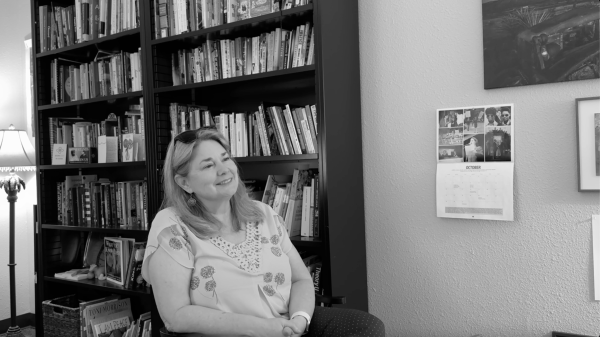From Nascence to Apotheosis, I Was Born for This

October 13, 2015
There’s nothing but sand as far as the eye can see. An endless desert marked by countless tombstones and buried ruins. A lone, robed figure sits up in the vast wasteland, having no memories of how they got there, who they are, where they are, or what they’re even supposed to do. Standing up, they begin to walk towards a tall dune, making it to the top, and that’s when they see it. Off in the distance, many, many miles away, is The Mountain. Split down the middle with light glowing between the two peaks, it’s already obvious that this is where they need to go. So begins an experience unlike any other.
First released on March 13, 2012 for the PS3 and later ported over to the PS4 in July of 2015, Journey is Thatgamecompany’s third game, following the release of flOw in 2007 and Flower in 2009, and is considered not only the company’s magnum opus, but also one of the greatest and most beautiful PS3 games ever made. The player takes control of a lone figure known only as The Traveler, a member of a race once known as the Rythulians. When the player wakes up, they’re all alone in the desert, but after the intro, it becomes apparent that your goal is to make it to The Mountain.
The controls for Journey are very simple. The right stick or motion of the Six-Axis controller moves the camera, the X Button is to jump and float, and Circle is to sing and activate structures. In order to jump, energy is needed, and that’s where The Traveler’s scarf comes in. As you journey (heh) towards The Mountain, you will come across glowing sigils that extend the length of your scarf. Acting as your energy meter, the longer your scarf is, the longer you’ll be able to jump and float around before you need to replenish your energy. Singing, in addition to just being fun, activates certain objects. Just tapping Circle sends out tiny melodic pings, but the longer you hold the button, the larger the wave sent out is, allowing you to activate multiple glyphs.
The story is simple at first, but becomes deeper and more complex as you get closer to The Mountain. Scattered throughout the levels are Ancient Glyphs that, when activated by singing, will reveal a carving that shows what life for the Rythulian people was like in ancient times. More direct information comes in the forms of Confluences, visions given to The Traveler at the end of every level by a series of white-robed Rythulian spirits that tell the rise, and eventual fall, of their civilization. Throughout all of this, not a single word is uttered in Journey. The story is all told through the Ancient Glyphs, Confluences, and the music that accompanies the latter. What starts off as a calming, if somber experience, eventually takes a turn for darker tones when you travel underground and come face to face with something long forgotten…
One of the core aspects of the game is that, eventually, you’ll come across another Traveler being controlled by another person. You won’t be able to see the person’s name or even talk to them in the conventional sense. This is where singing becomes even more important. Even without using words, you can sing to your companion to get their attention about a glyph or a symbol that can be collected. This sort of interaction is very unique and something I can’t recall being in any game before. It forms a bond that seems stronger than most others in that, even though you can’t speak, you grow together and learn about each other as you travel to The Mountain.
One criticism that a number of people have with the game is that, for some, the length of the game is too short for the price the game is at ($14.99). Length has never been an issue for me, especially for this game, but I can see where people might have issues. The game has a total of eight levels and, if you want, you can easily speed through the game if you know where to go and don’t try to collect the sigils and find all of the murals. However, I believe that just trying to finish as fast as possible through Journey is not how it should be played. It’s more about the exploration, the experiences shared with your companion, and the journey itself than seeing how fast you can complete this game. If you take your time to just look around, explore, and just enjoy the atmosphere, I think you’ll get so much more out of it.
The music is probably my favorite part of the game and, along with the visuals, is what stands out most about the game. Composed by Austin Wintory, Journey’s soundtrack is beautiful, somber, uplifting, and emotional, perfectly capturing the game’s mood and story. Once you play through the game and start listening to the soundtrack, you’ll be able to tell just where The Traveler would be at that moment. Currently available on iTunes, the music for Journey was also nominated for a Grammy for Best Score Soundtrack for Visual Media in 2013, along with The Adventures of Tintin: The Secret of the Unicorn (John Williams), The Artist (Ludovic Bource), The Dark Knight Rises (Hans Zimmer), and The Girl with the Dragon Tattoo (Trent Reznor).
Going personal for a second here, Journey is, without a doubt, my favorite game of all time. No other game has managed to invoke as many emotions as this one has. NieR was a VERY close second, but when it comes down to it, whereas NieR is very tragic, dark, and depressing, Journey, while still a bit melancholic, is uplifting, inspiring, and cathartic. It allows the player to just take in the scenery and atmosphere at their own pace or with another, exploring the shimmering sands to look for murals and sigils and playing with the tiny, gentle cloth creatures that act like schools of fish, dolphins, or whales. The ending in particular, while very simple, is powerful in its own right. It will take a LOT for any other game to top this one in my mind.
I wholeheartedly recommend Journey to anyone who owns a PS3 or PS4. Those who buy the game on the PS3 will be able to buy the PS4 version for free if you decide to upgrade your console. I completely understand that this game will not be everyone’s cup of tea, but I still encourage you to give it a try. I would suggest starting off watching the trailers for the game, followed by listening to all of the music on Austin Wintory’s YouTube page. If you’re sold by then, then there’s a very good chance you’ll like the game. This is most definitely a gaming experience unlike anything you might have seen before.














